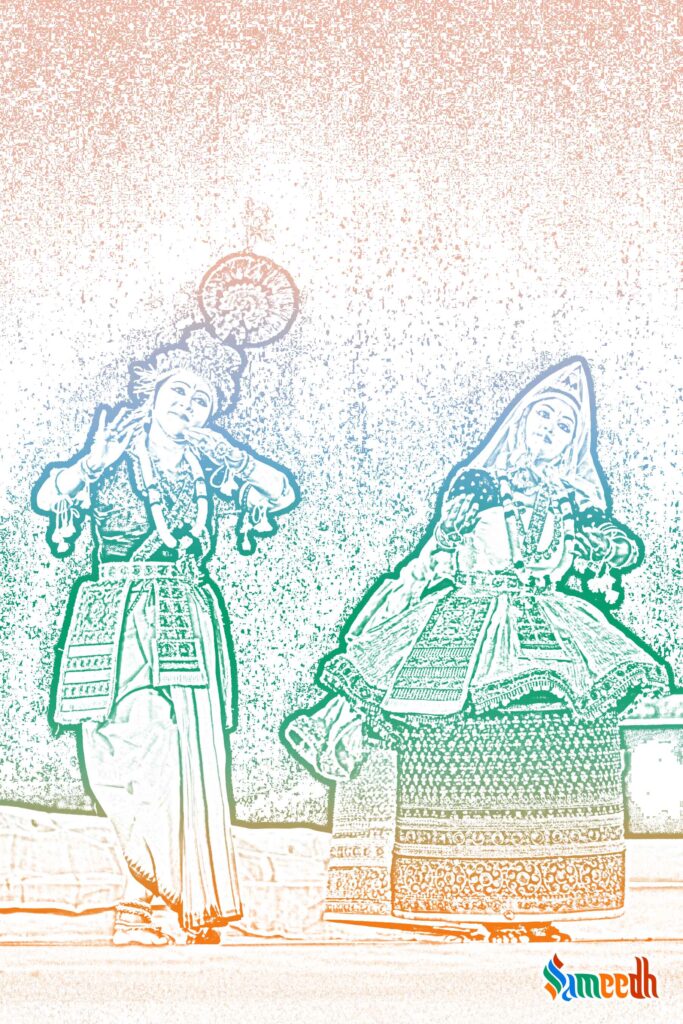Manipuri dance is one of the principal forms of Indian classical dances. It emerged in the remote and scenic Indian state called Manipur, located in the northeastern part.

One of India’s most well-known traditional dance styles, Manipuri, is very popular in the rich North East customs and culture. Manipuri dance is regarded as a notable manifestation of Bhakti Ras. It is known for its themes of Hindu shastras, which include Radha Krishna bhakti, Vaishnavism and Nataraj Natyam as per Shaivism.
SIGNIFICANCE
Other themes that are shown in this dance tradition include Shaktism, Shaivism, and the native gods like Umang Lai at the Manipuri festival ‘Lai Haraoba’. Although this dance style has its roots in the ancient Sanskrit Hindu text ‘Natya Shastra’, it is named after Manipur where it originated. This form notably combines Southeast Asian and Indian traditions.The Manipur region’s renowned ancient dance tradition originates from the classical Indian epics ‘Ramayan’ and ‘Mahabharat’, in which the dance masters of this region are referred to as ‘Gandharvs’.
HISTORY
The Manipuri people typically identify themselves as the Gandharvs who were vocalists, musicians, artists and dancers affiliated with devtas and who are documented in the Vedic literature. Early mediaeval Southeast Asian temples feature dancer-like statues of the Gandharvs. Furthermore, the region is referred to as ‘Gandharv des’ in historical Manipuri manuscripts. The term ‘Chingkheirol’, is commonly used in Manipur to refer to this oral dancing practice that is verbally conveyed to women. It is believed that Goddess Usha, who is also mentioned in the Rigved, had taught this dance form to women.
Along with other dance genres in India, the Manipuri dance experienced a slump in the 19th century during British rule. Following the anti-dancing campaign of 1892, it was well known that dancers and performers were harassed and humiliated. Following numerous protests, the culture is reported to have eventually come back into existence and gathered pace after the declaration of independence of India.
The origination of this dance dates back to ancient times that come from beyond the history that we know today. Manipuri references Gods and Goddesses like Shiv and Parvati who are known to create this universe.
The divine Radha-Krishna dance, known as Rasleela, originated in Manipur. Rasleela is represented with characters of Radha, Krishna, and Gopis. The theme generally focuses on separation of Radha from Krishna.
Manipuri dance sequences follow rhythmic actions and dance moves to depict the stories that have traditional origins. The costumes are popularly represented by a stiff skirt that extends until feet. To depict Krishna, the character wears typical yellow dhoti, known as Pitaambar. Since peacock feather also represents Lord Krishna, a crown of peacock feathers is donned upon by the character that represents Krishna.
Manipuri depicts all the forms of stories of daily life like child birth, wedding, death, and other significant events of a human life.
AMALGAMATION OF DANCE AND DEVOTION
Manipuri dance is typically performed from August through November during the season, once in March and April during the Holi festival in Vasant ritu, and once each full moon evening. There are several dance compositions that are dedicated to Radha Krishna and each of the Gopis namely Sudevi, Champaklata, Chitra, Lalita and Vishakha. Manipuri dance includes acrobatics as well, and the basic dance movements are called charis or chalis. Traditionally, women and men both perform manipuri dance, which is supported by chorus singing. The dance movements are distinguished by the performers’ graceful and fluent expressions and movements. Male performers typically feature more powerful and muscular movements in the hand and arms than female performers.
COSTUMES AND MUSICAL INSTRUMENTS
Male dancers usually wear a bright coloured dhotra (dhoti), which covers the lower portion of their bodies from the waist and offers flexibility for footwork. Performers also wear a crown adorned with peacock feathers, just like Bhagwan Krishna. The typical clothing for male musicians is a white dhoti, turban, and shawl on the left shoulders. A female dancer typically dons a Potloi costume, which represents the Gopis. The dancers decorate their necks, hands and legs with floral garlands or jewellery. Meidingu Bhagyachandra Maharaj introduced these outfits for dancers portraying Gopis in the ‘Raas Leela’ dance.
The most unique and well-known attire is the kumin dress, which consists of a long, cylindrical skirt with a thickened bottom which is adorned with fine silver and golden embroidery. The transparent skirt that is wrapped around the waistline and forms the top border of the kumin is known as the trikasta and looks like a flower. Manipuri women artists also wear a velvet shirt and white covering for their heads.
Traditional karthal cholom dances feature men drummers who play cymbals or karthals while moving in a circle in a sequential formation. Whereas, women perform ‘Mandilla Cholom’ by striking cymbals attached with tassel strings. The dance songs generally use Sanskrit and Maithili, whereas narrative songs typically feature poetry by Jaydev, Govind Das and Chandidas.
